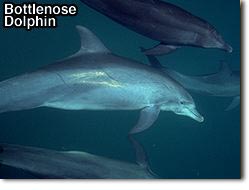Bottlenose dolphin (Tursiops truncatus )
Family Delphinidae
 Description: Largest of the dolphins. In the UAE, some have been measured to be a little under 3m in length. Even from a fair distance, one may notice the robust head and relatively short and stubby beak, from which this dolphin gets its name. Close up, it is possible to see the clear crease that separates the beak from the bulbous forehead, or melon. Along with the Indo-Pacific humpback dolphin, the bottlenose is the only other dolphin likely to be seen regularly from land. It is bulkier and usually a darker colour than the Indo-Pacific humpback dolphin. Larger adults often bear white or pinkish scars from aggressive behaviour. Typically in groups of about 5-35 individuals, bottlenose dolphins are fast, powerful swimmers often riding the bow wave of boats, and as their reputation in aquaria attests, they are inquisitive and playful and are capable of some spectacular aerial acrobatics. Description: Largest of the dolphins. In the UAE, some have been measured to be a little under 3m in length. Even from a fair distance, one may notice the robust head and relatively short and stubby beak, from which this dolphin gets its name. Close up, it is possible to see the clear crease that separates the beak from the bulbous forehead, or melon. Along with the Indo-Pacific humpback dolphin, the bottlenose is the only other dolphin likely to be seen regularly from land. It is bulkier and usually a darker colour than the Indo-Pacific humpback dolphin. Larger adults often bear white or pinkish scars from aggressive behaviour. Typically in groups of about 5-35 individuals, bottlenose dolphins are fast, powerful swimmers often riding the bow wave of boats, and as their reputation in aquaria attests, they are inquisitive and playful and are capable of some spectacular aerial acrobatics.
Habitat: Feeds over deep water, and over sand, seagrass and reefs in shallow water.
Range: One of the commonest cetaceans in the UAE and the species most likely to be seen close to cities such as Abu Dhabi, Dubai, Sharjah and Fujairah. Those that live close inshore are relatively placid, not displaying the acrobatic energy of their slightly larger counterparts further out to sea.
Comments: The bottlenose dolphin is considered to be one of the most intelligent of cetaceans. In the UAE this is a species that will often find you, before you find it. As well as seeking human company, bottlenose dolphins also frequently swim with other species, ranging from Indo-Pacific humpback dolphins in the Arabian Gulf to sperm whales in the Gulf of Oman.
|